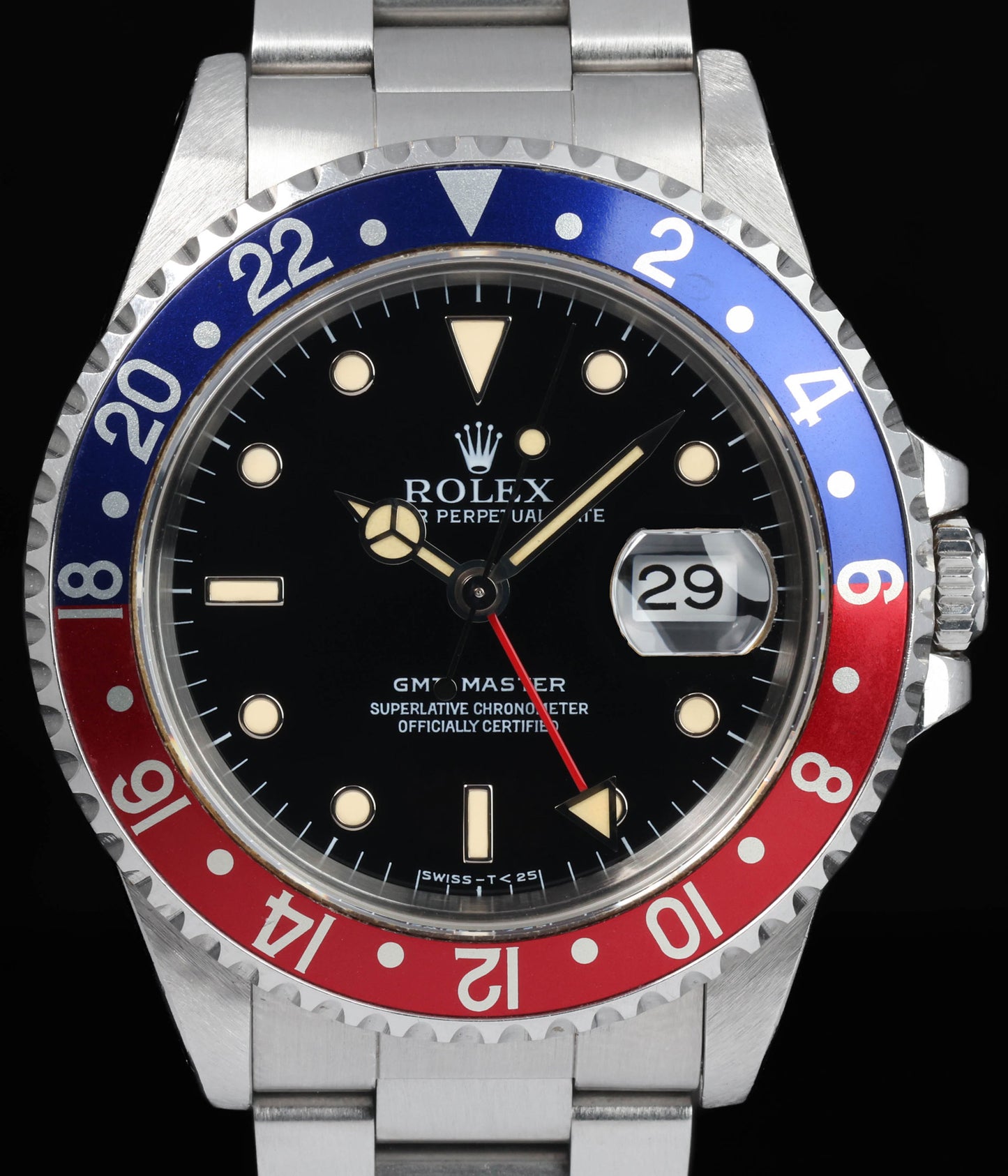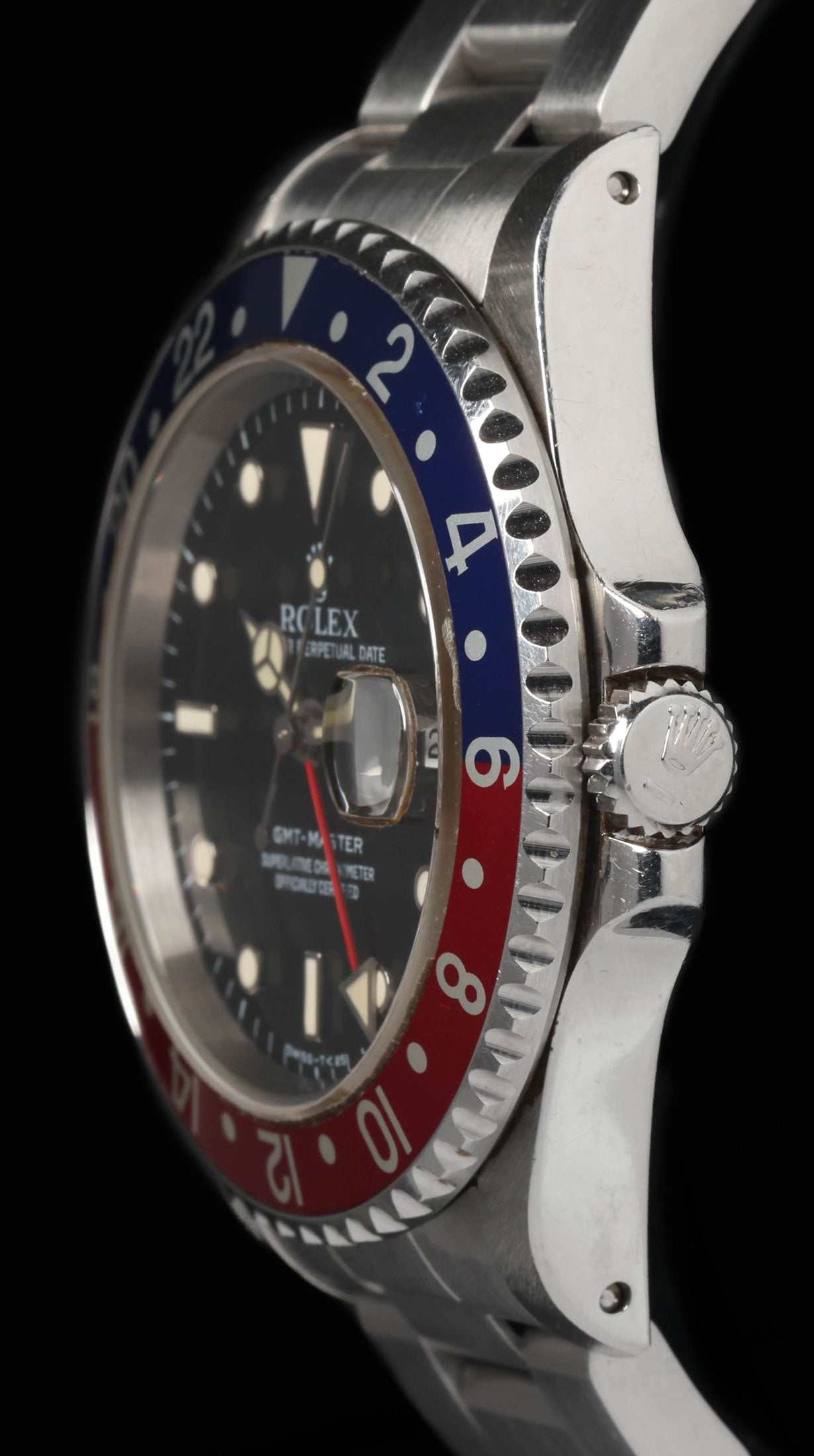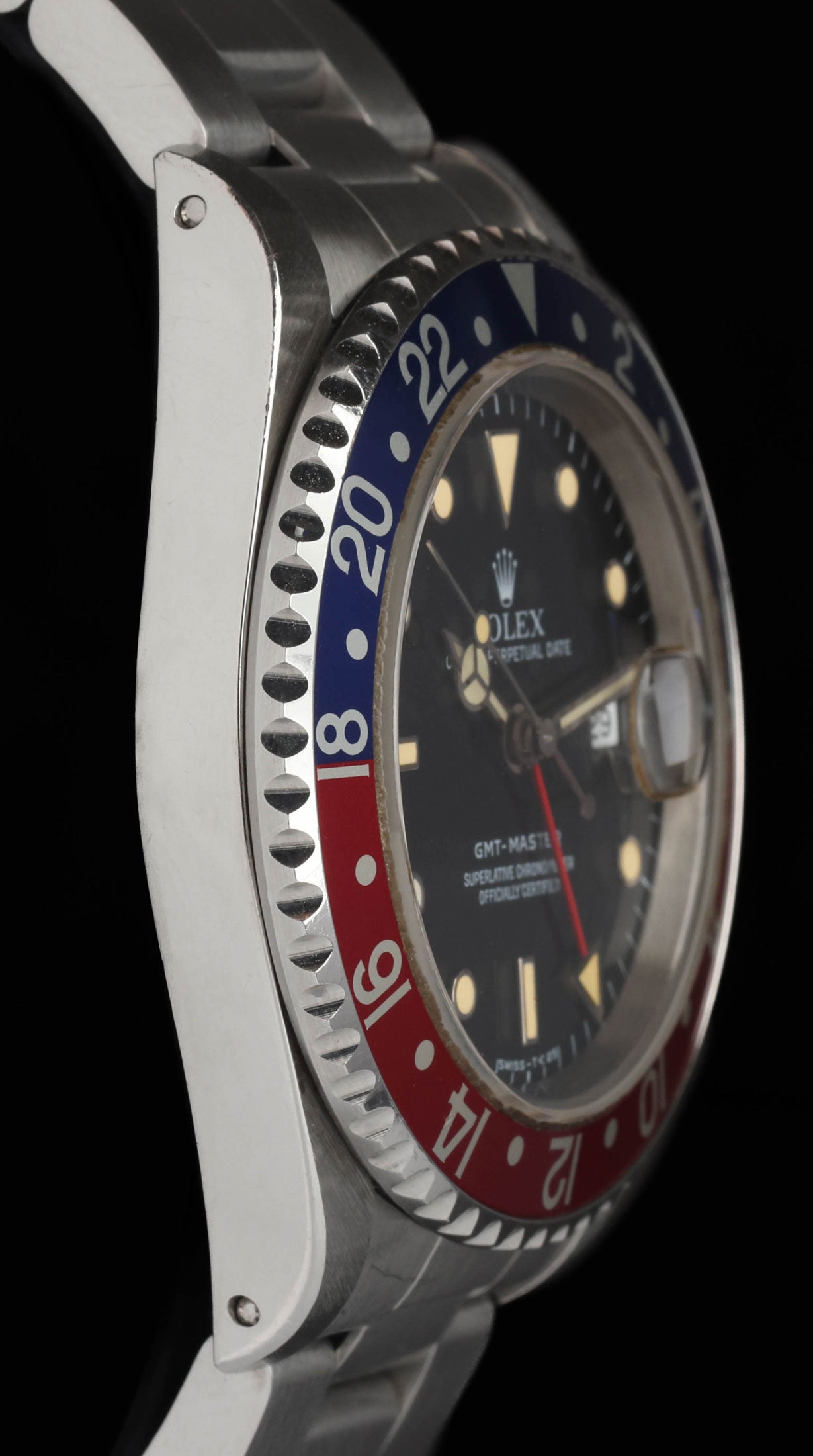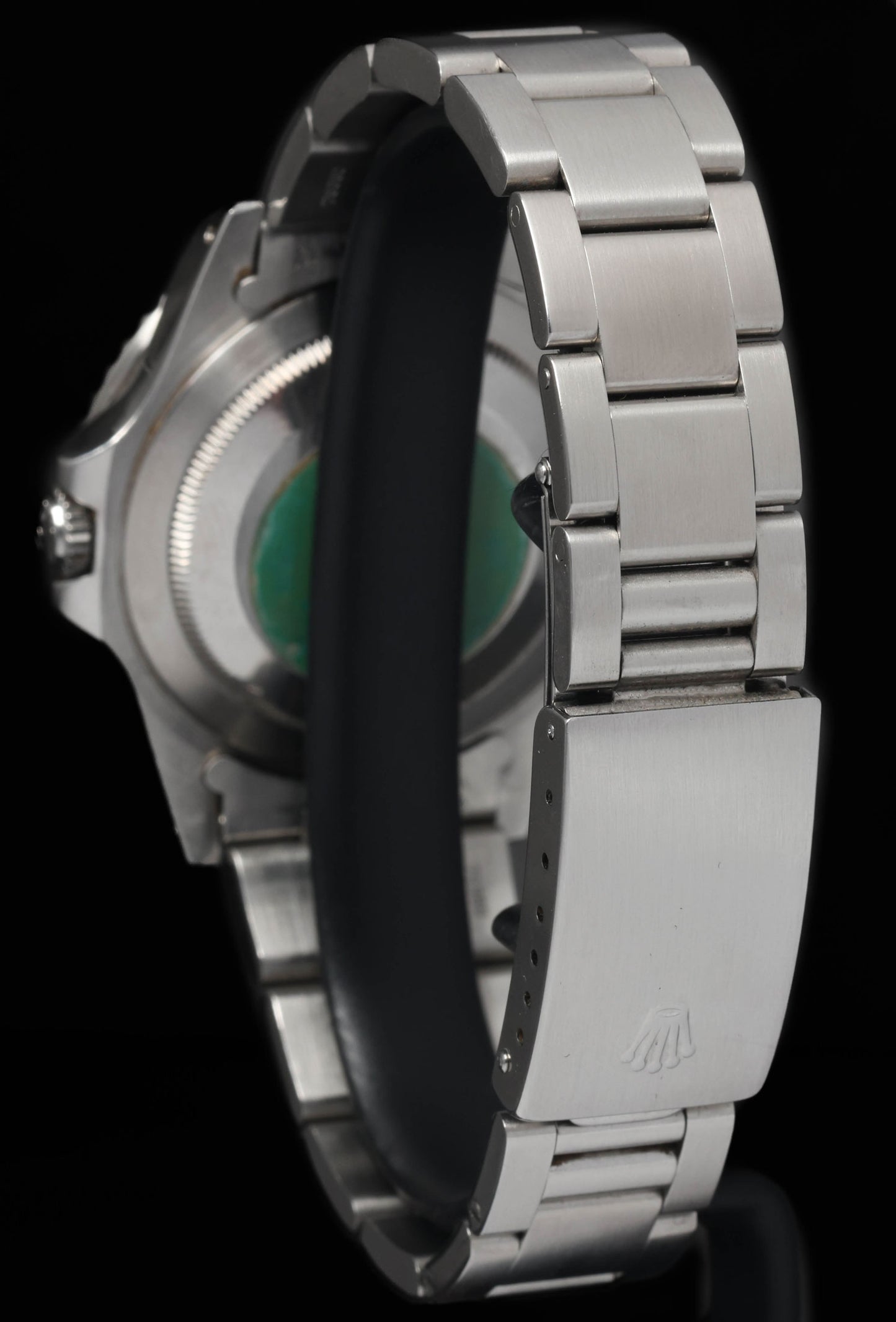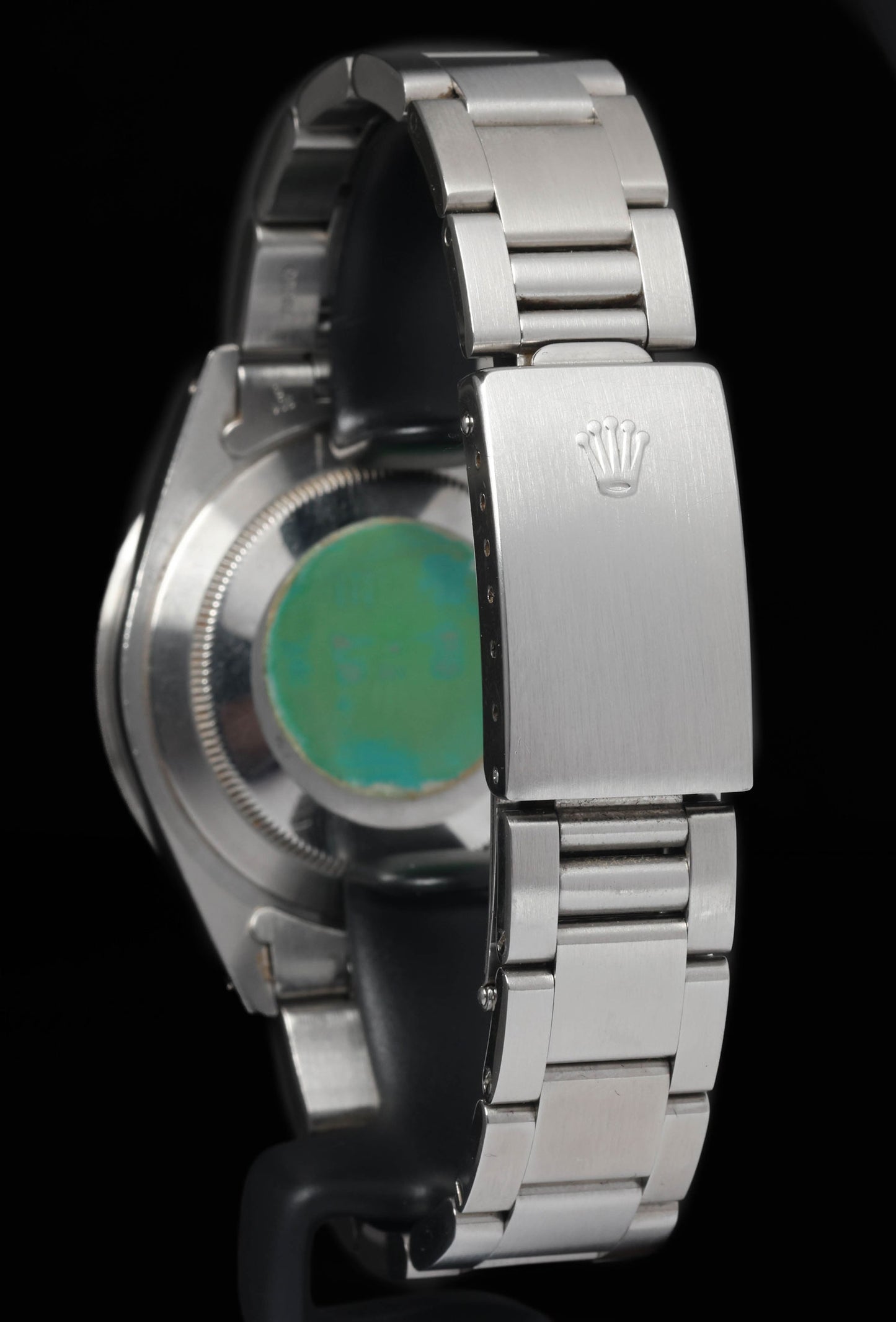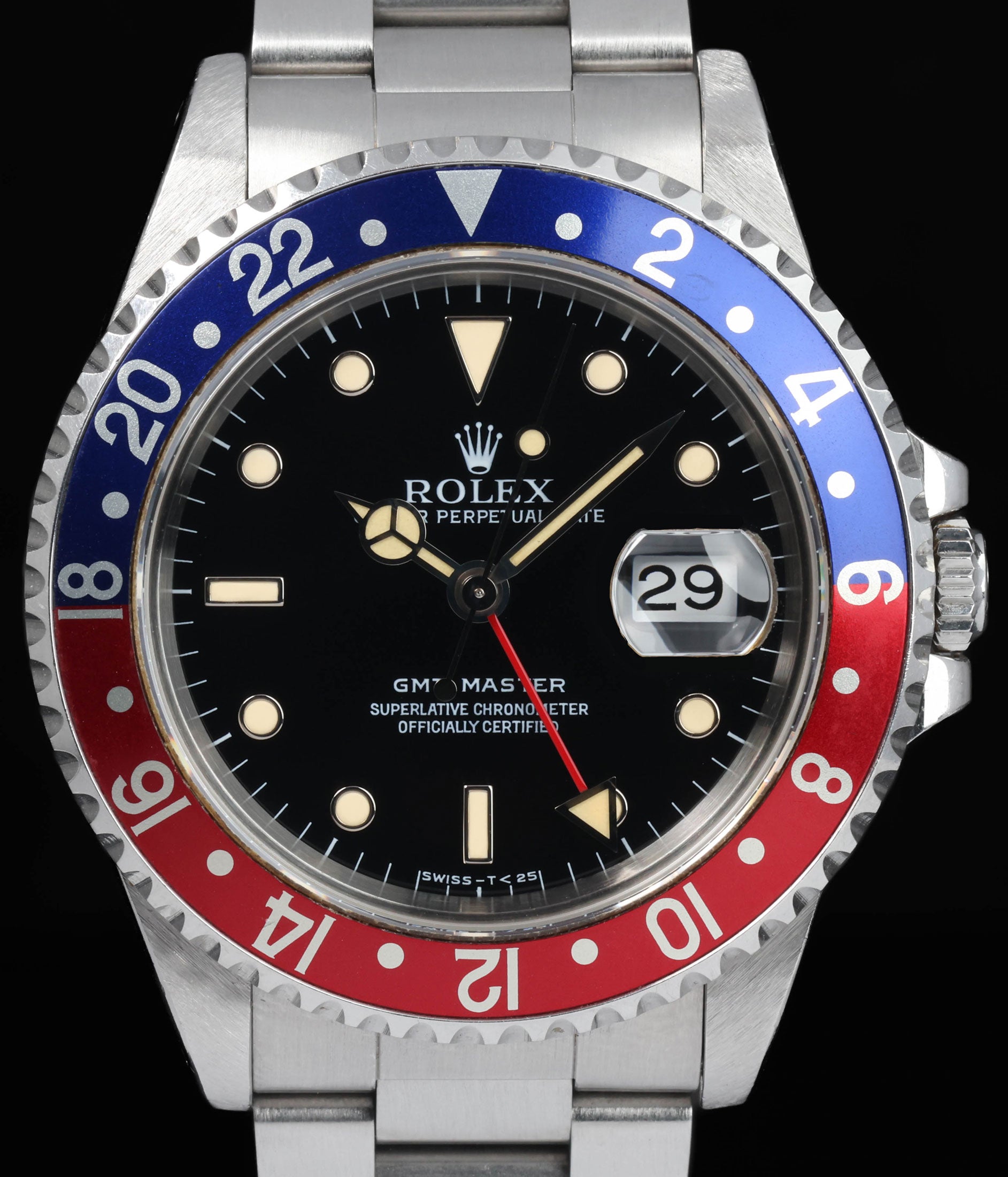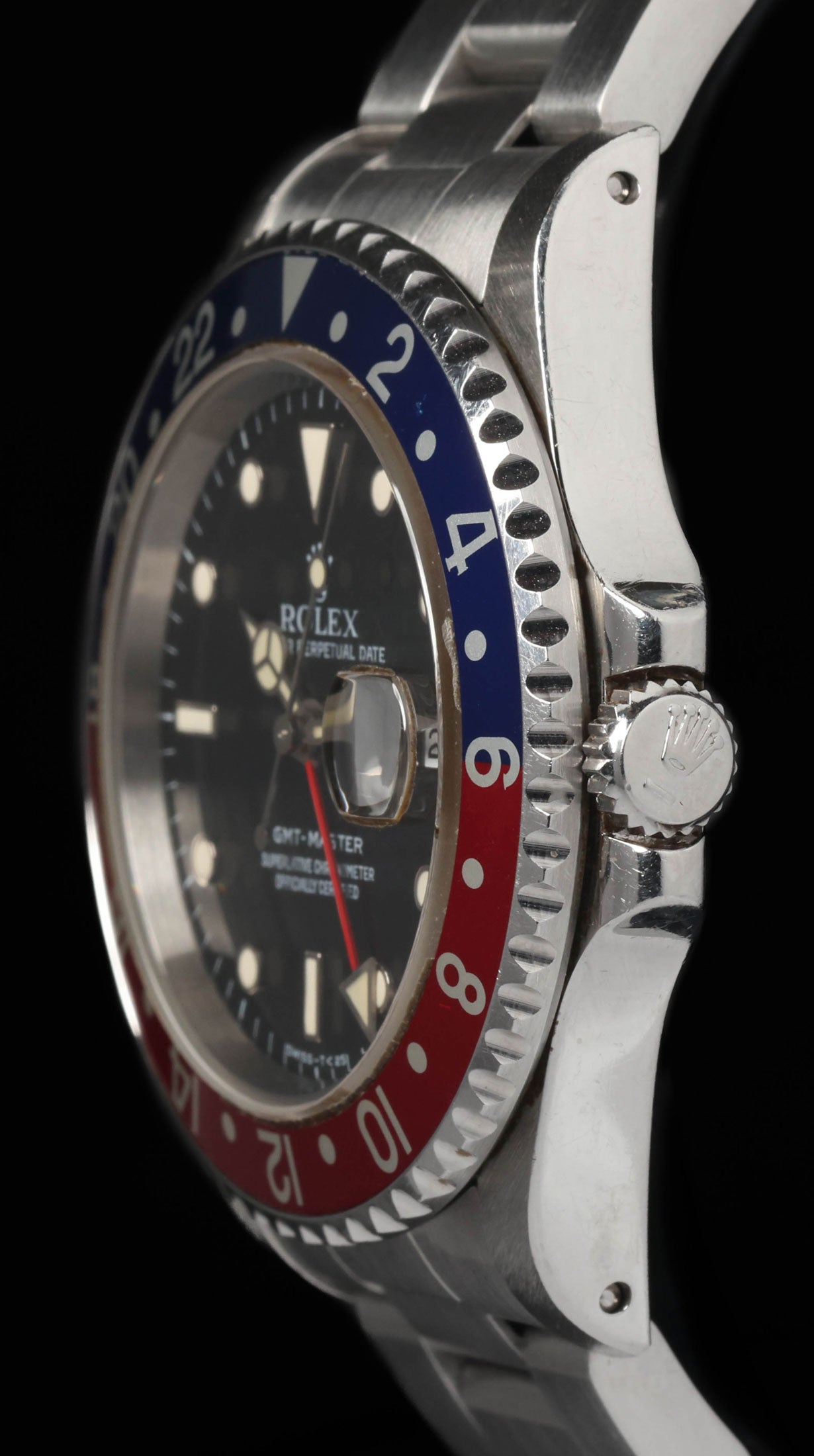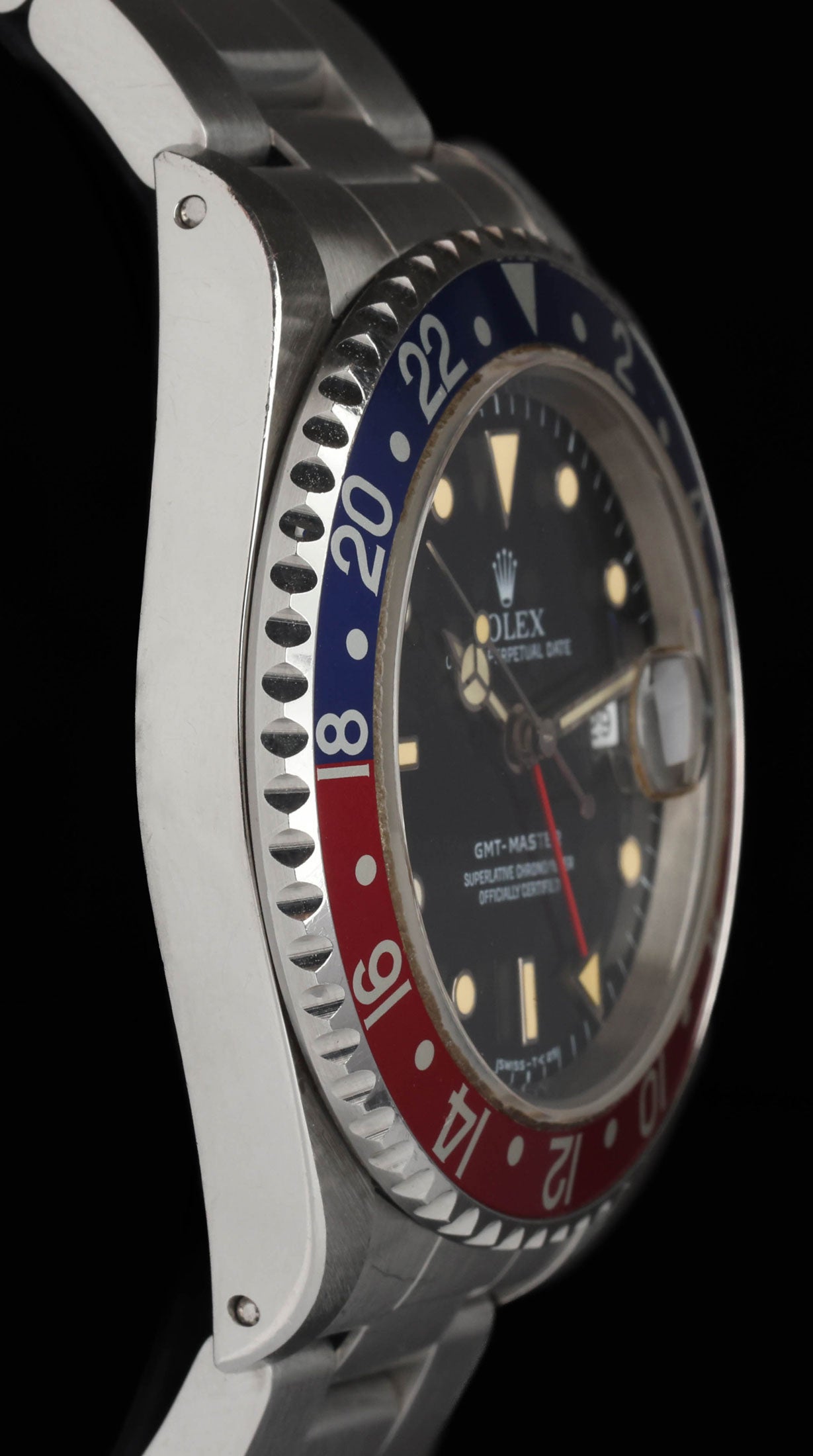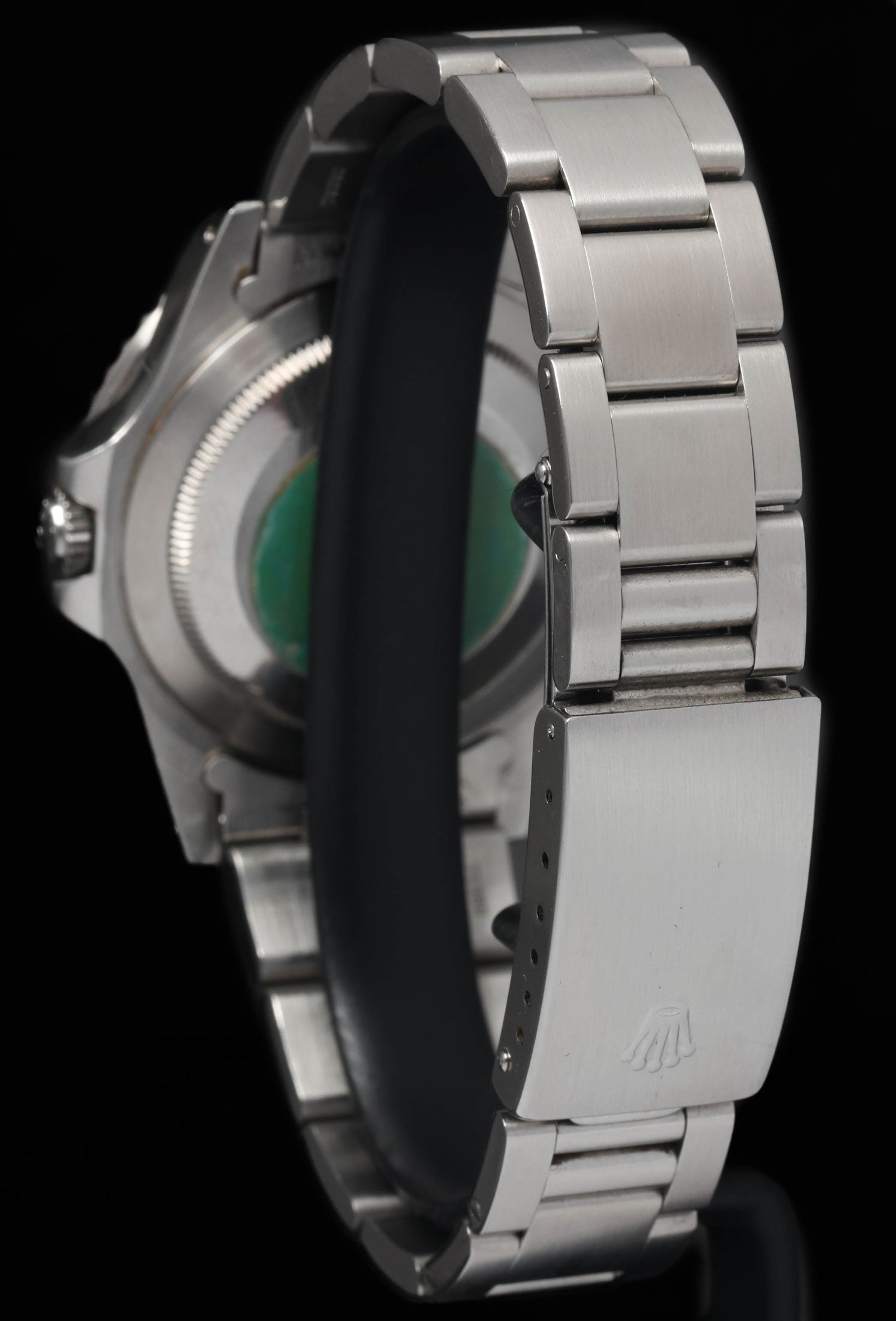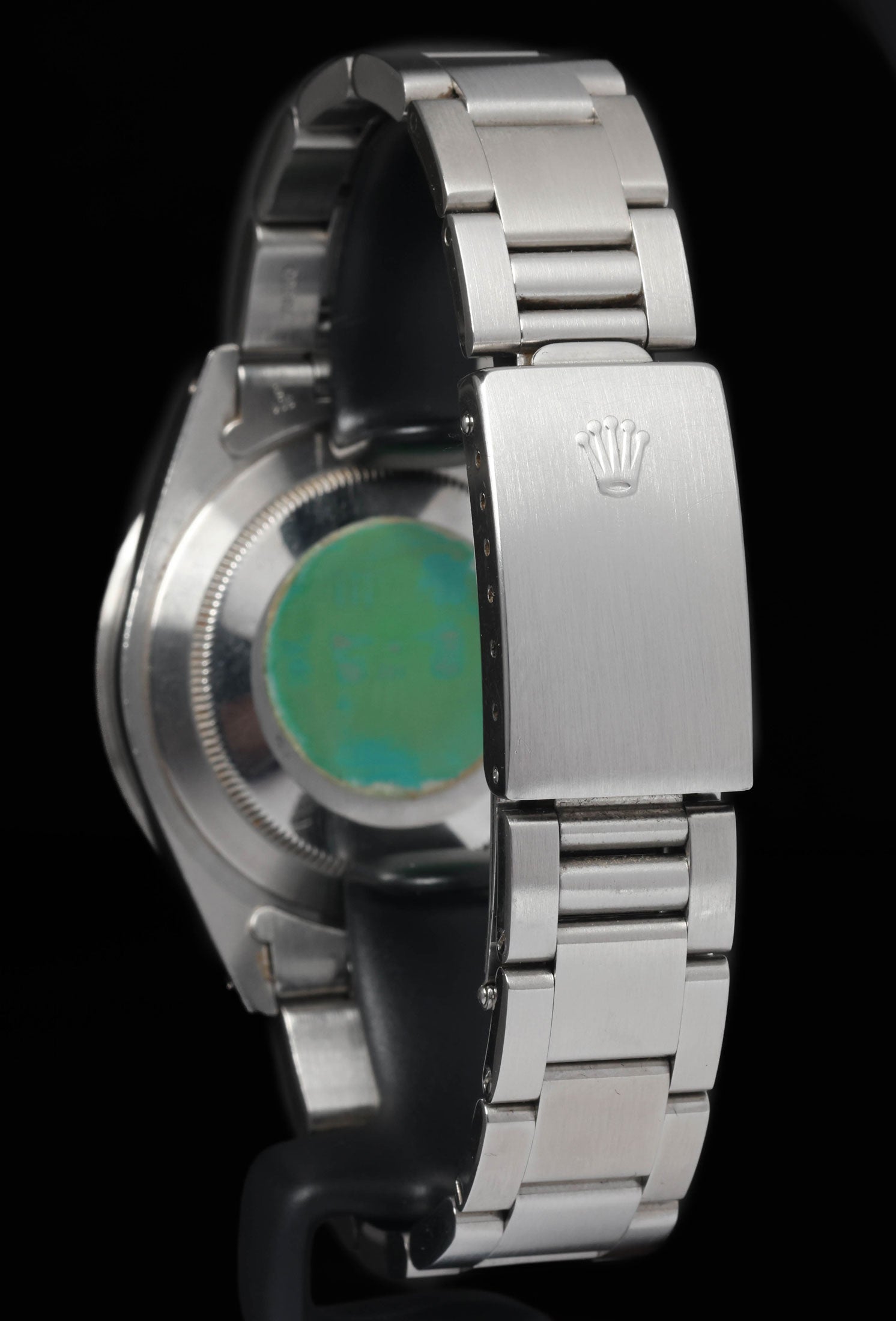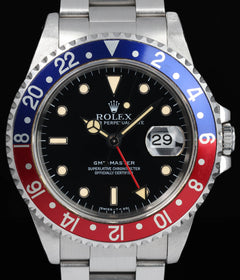Crown Vintage
Rolex GMT Master 16700 'Pepsi' 40MM 1993
Rolex GMT Master 16700 'Pepsi' 40MM 1993
Couldn't load pickup availability
Rolex GMT Master 16700 'Pepsi' 40MM 1993
The case of this Rolex GMT-Master 16700 presents in very good condition, with very light wear visible and strong factory lines remaining intact. The accompanying Oyster bracelet is also in very good condition, exhibiting minimal stretch and only slight signs of use, retaining excellent integrity for daily wear. The dial and hands are in excellent condition, with crisp printing, strong patina'd luminous plots, and no visible imperfections. Overall, this is a superbly preserved example of the 16700 “Pepsi,” combining a sharp case, solid bracelet, and flawless dial and hands.
Share
Why we love this watch
Why we love this watch
Rolex GMT-Master 16700 S-Serial
Introduction
The GMT-Master reference 16700 represents the final chapter of the original GMT-Master line. Introduced in the late 1980s, it carried forward the DNA of the model first created in 1954 for Pan Am pilots, while existing alongside the more complex GMT-Master II. Unlike the II, the 16700 retained a fixed 24-hour hand, staying true to the concept of a two-time-zone tool watch in its purest form. By the time the S-serial examples were produced in the mid-1990s, the reference had settled into a well-defined identity. It was robust, legible, and distinctly Rolex, bridging the gap between its vintage predecessors and the more modern iterations that would follow.
The GMT-Master Lineage
The story of the GMT-Master begins in the jet age, when intercontinental travel demanded a practical solution for tracking time across multiple zones. Rolex’s answer was the reference 6542, with a 24-hour hand and a rotating bezel that allowed pilots to keep track of both local and home time. The watch evolved through the 1675 and then the 16750, each step bringing technical and cosmetic refinements.
The 16700 was launched as a companion to the newly developed GMT-Master II 16760. The two watches looked nearly identical, but functionally they diverged. The GMT-Master II featured an independently adjustable 24-hour hand, effectively allowing the wearer to track a third time zone. The 16700 stayed loyal to the traditional format: the 24-hour hand was linked to the main timekeeping hands, and a second zone was read off the bezel. This made the 16700 simpler, slightly thinner, and less expensive than the II, appealing to those who wanted the classic GMT experience without additional complication.
Case and Bezel Design
The 16700 carried the Oyster case in stainless steel, measuring 40mm with crown guards and a Triplock crown. Its waterproofness was rated to 100 metres, making it a practical travel companion and a solid everyday sports watch. The finishing followed Rolex’s established approach, with brushed lugs and polished flanks creating a balance of tool functionality and subtle refinement.
One of the defining features of the GMT-Master is the rotating 24-hour bezel, and the 16700 was available with two insert options. The blue-and-red “Pepsi” insert echoed the heritage of the line, tracing its roots back to the 1950s. The all-black insert provided a more understated look while still delivering full functionality. These aluminium inserts often develop character over time, fading into unique shades that underscore the watch’s age and use.
Dial and Lume Details
In the mid-1990s, dials on the GMT-Master 16700 were matte black with white printed text. The luminous material was tritium, indicated by the “SWISS-T<25” marking at six o’clock. The tritium lume plots were ringed in white gold, a detail Rolex introduced in the 1980s and carried forward across the sports watch range. Over time, tritium often ages to a creamy hue, lending warmth and character to these watches.
Bracelet Options
Rolex supplied the 16700 primarily with the Oyster 78360 bracelet, fitted with 501B end links. The bracelet was robust yet slim, perfectly suited to the proportions of the case. An optional Jubilee bracelet, reference 62510H with 550 end links, was also available and offered a dressier alternative. Both bracelets carried the flip-lock clasp that reinforced the watch’s sports credentials.
It is worth noting that the solid end link 78790 bracelet had not yet become standard during this period. That came later, near the end of production. For an S-serial, the correct pairing remains the 78360 Oyster or the Jubilee option, depending on the buyer’s preference at the time of purchase.
Movement: Calibre 3175
The GMT-Master 16700 was powered by Rolex’s calibre 3175, an automatic movement developed from the earlier 3075. The calibre 3175 provided central hours, minutes, and seconds, a quickset date, and the linked 24-hour hand. While not as mechanically complex as the independently adjustable 24-hour hand in the GMT-Master II’s calibre 3185, the 3175 was robust and dependable. It ran at 28,800 vibrations per hour and featured a power reserve of around 48 hours.
This movement was exclusive to the 16700, making it unique within the Rolex line-up. Its simplicity contributed to the slightly slimmer case profile, which some prefer for comfort and wearability.
The GMT-Master in the 1990s
During the 1990s, the GMT-Master had evolved from a specialised tool for airline pilots into a mainstream sports watch. Global travel was becoming more accessible, and the GMT function remained highly relevant. At the same time, Rolex was increasingly positioning its sports watches as luxury items, refining their fit and finish while retaining their functional roots.
The 16700 embodies this balance. It remained a straightforward two-time-zone watch, less costly than the GMT-Master II, yet it bore all the hallmarks of a modern Rolex: sapphire crystal, quickset date, and white gold surrounds on the lume plots. It represented Rolex’s approach of offering both heritage and innovation side by side, appealing to those who valued tradition as much as progress.
Historical Importance of the 16700
The 16700 holds a special place in the GMT-Master story as the final reference in the original line. When production ended in 1999, it marked the conclusion of an era that had begun with the 6542 more than forty years earlier. From then on, the GMT-Master II carried the torch exclusively.
This distinction gives the 16700 a clear historical identity. It is the watch that closed the book on the original concept, retaining the linked 24-hour hand and bezel-based dual-time reading. It is also the only reference to feature the calibre 3175, further underlining its singular place in Rolex’s catalogue.
Evolution of the Dial
Understanding the dial progression of the 16700 adds depth to its history. Early examples carried tritium lume, with “SWISS-T<25” text. Toward the very end of production, Rolex transitioned to Luminova, marked simply “SWISS.” These late dials had bright white lume that glowed green in the dark. Because the 16700 was discontinued in 1999, it missed the full switch to Super-Luminova that appeared in subsequent models.
An S-serial watch belongs firmly in the tritium era. Its lume plots, depending on age and exposure, will often have mellowed into warmer tones, a quality that tritium is known for and one that adds individuality to each piece.
Wearing the 16700 Today
On the wrist, the 16700 remains highly versatile. Its 40mm case and Oyster bracelet make it comfortable for daily wear, while the slim profile compared to later GMT-Master IIs adds to its appeal. The rotating bezel allows quick adjustments when moving between time zones, maintaining the original utility that defined the line.
A Pepsi bezel insert emphasises the watch’s heritage and offers a striking, colourful presence. The black insert provides a more restrained look, blending easily into almost any setting. Both reflect the dual character of the GMT-Master as both a travel tool and a refined sports watch.
The Role of the 16700 in the Rolex Sports Watch Line
Within Rolex’s broader sports watch family, the 16700 illustrates the brand’s philosophy of incremental change. Rather than overhauling the GMT-Master, Rolex introduced the GMT-Master II while continuing to produce the original in parallel. This approach respected tradition while offering innovation to those who wanted it.
The result is that the 16700 stands as a transitional model — modern in features like sapphire crystal and quickset date, yet rooted in the original GMT-Master concept. Its discontinuation closed the door on that lineage, giving it a defined and lasting significance.
Final Thoughts
The Rolex GMT-Master 16700 in S-serial form represents the mid tritium era of the reference. With its Oyster case, matte black dial, and aluminium bezel insert, it captures the essence of the GMT-Master line while embracing the refinements Rolex had introduced by the 1990s. Powered by the calibre 3175, it remains unique in the brand’s history, the only model to carry this movement.
As the last of the original GMT-Masters, the 16700 stands as a milestone. It bridged vintage traditions and modern expectations, offering a pure two-time-zone function in a package that was unmistakably Rolex. Its place in the GMT lineage is secure: it is the watch that closed a chapter begun in the 1950s, leaving behind a legacy of clarity, functionality, and design continuity that continues to define the Rolex sports watch identity today.
Case & Bracelet
Case & Bracelet
- Case in very good condition, very light hairlines visible.
- Bracelet in very good condition, minimal stretch and wear visible.
- *Case Unpolished.
Dial & Hands
Dial & Hands
Dial & hands excellent condition with an even patina forming.
Warranty & Condition
Warranty & Condition
Crown Vintage Watches provides a minimum 3-month mechanical warranty on pre-owned watches, from the date of purchase.
The warranty covers mechanical defects only.
The warranty does not cover damages such as scratches, finish, crystals, glass, straps (leather, fabric or rubber damage due to wear and tear), damage resulting from wear under conditions exceeding the watch manufacturer’s water resistance limitations, and damage due to physical and or accidental abuse.
Please note, water resistance is neither tested nor guaranteed.
Shipping and insurance costs for warranty returns to us must be covered by the customer. Returns must be shipped via traceable courier. Return shipment must be pre-paid and fully insured. Collect shipping will be refused. In case of loss or damages, the customer is liable.
Our Pledge
At Crown Vintage Watches, we stand by the authenticity of every product we sell. For added peace of mind, customers are welcome to have items independently authenticated at their own expense.
Condition
Due to the nature of vintage timepieces, all watches are sold as is. We will accurately describe the current condition and working order of all watches we sell to the best of our ability.
Shipping & Refund
Shipping & Refund
